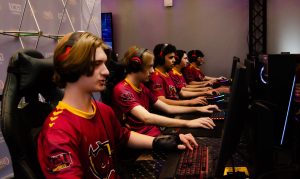- Slug: Sports-ASU Overwatch Esports. 950 words.
- One photo available.
Sammy Nute
Cronkite News
TEMPE — Grand Canyon University showed off its multi-million dollar esports facility in mid-March by hosting the Western Cactus League 2024, the first in-person esports competition to host all four major Arizona universities.
GCU, which has been at the forefront of investing in the Valley’s esports scene, opened its doors to Arizona State, the University of Arizona and Northern Arizona University at the 3,200-square-foot Esports Arena. Built in 2019, the facility houses more than 70 personal computers and multiple consoles.
However, it wasn’t the host team that dominated the event that weekend.
Arizona State Overwatch stole the show en route to a tournament victory, adding to a stellar year of rapid growth. ASU climbed the Overwatch College Rankings into the nation’s top 10 without significant financial support from the school as a club sport. The program’s potential was on display amid its rise in the rankings, despite a decision by ASU’s student government to withdraw critical financial support this spring, according to the team.
“I genuinely believe if we had even remotely a certain amount of funding, we would end up probably the best esports program in the country,” said ASU Overwatch coach Asad Jamal. “No other funded esports program has the reach that ASU esports does.”
The ASU Overwatch team was ranked as high as fifth nationally earlier this season by the Overwatch College Ranking Association and now sits ninth.
In the latest OWCRA rankings, only six of the top 20 teams are public universities. However, other top-20-ranked public schools such as Boise State and UC Irvine still offer scholarships for their esports teams. Boise State’s esports program has operated for seven years and offers an undergraduate certificate in esports to students. GCU offers scholarships of up to $2,500 for their various teams.
“The best schools are able to provide esports scholarships for people, which is a huge draw,” said Devin Fish, creator of the OWCRA rankings. “I think that’s what people don’t talk about as much, as it is the intangible part of that money.
“There is an amount of trust and respect that the higher-ups at the university give to an esports program for them to give them the money.”
ASU Overwatch’s ascendance has coincided with a general rise in esports. With an audience of more than 500 million people worldwide, esports is on par with Major League Baseball as a premier form of competitive entertainment. Currently 170 colleges offer at least partial scholarships for their esports teams.
Due to its popularity among students, Arizona State Esports Association Club boasts 10 teams that compete against other schools. In the past, the esports club received around $600 per semester in funding from the ASU student government, using that money to fund jersey orders and to pay for limited local travel for qualifier tournaments across the Valley.
Other costs had to come out of the members’ pockets, but most tournaments for esports are online, so the team’s travel costs are limited.
However, this spring, the student government reached its budget limit for the semester and left the esports club without any financial support, according to Jamal.
Without the funding from above to secure scholarships for players, the ASU Overwatch team had to lean on local talent. Luckily, help came from one of the Valley’s high school esports dynasties. The Brophy Prep Overwatch program is the three-time reigning Overwatch National Champions, and two of the team’s recent stars decided to step up for ASU.
Jonathan “JMAN” Mena and Holden “Scylla” Huber finished their time at Brophy losing only one match throughout their careers but never thought college Overwatch would be an avenue when they arrived at ASU in 2022.
“I didn’t think the team would be worth my time,” Huber said. “My thought process was that if the team isn’t competing at the highest level, it wouldn’t be worth me playing because we wouldn’t win anything.”
However, after Mena joined the Sun Devils club and told Huber that the esports team had the potential to field a competitive roster, Huber joined last spring and helped form the current roster. Since then, ASU Overwatch has stacked huge wins and climbed the OWCRA rankings.
“When I looked at Arizona State last year, they kind of exploded onto the scene for me,” Fish said. “I didn’t really know too much about them prior to last spring. That’s when they really just came out of nowhere and started pulling off wins against the top-20 teams like it was nothing, so we’re like, ‘Oh my gosh, these guys are crazy.’”
ASU closed out last spring ranked as the 11th-best team in the country but had fallen to No. 14 by the fall. Then, proving worthy of a top-10 program,the Sun Devils rose up the rankings again.
“Throughout the whole last semester, we were very much like, ‘We need to prove these people wrong and show them that just because we haven’t been on the scene, and just because the other schools might have a bigger name and budget, it does not mean that you should count us out,” Jamal said.
Due to strong play throughout the season, ASU clinched one of the top four seeds at May Madness, an event held by the Collegiate Esports Commissioner’s Cup to determine the best Overwatch team in the country. The Sun Devils, of course, will pay their own way to the event, but May Madness will provide a chance to prove that an unfunded team can win among the elite of college esports.
Maybe then the team can receive the funding the members feel they deserve.
“This whole year, they’ve been focused on wanting to prove to people that we are not just a top-10 team. We are (the) top one,” Jamal said.
For more stories from Cronkite News, visit cronkitenews.azpbs.org.
